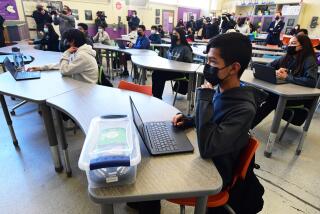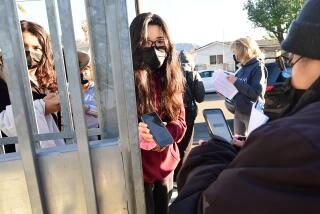Coronavirus has schools preparing for the last resort: closures
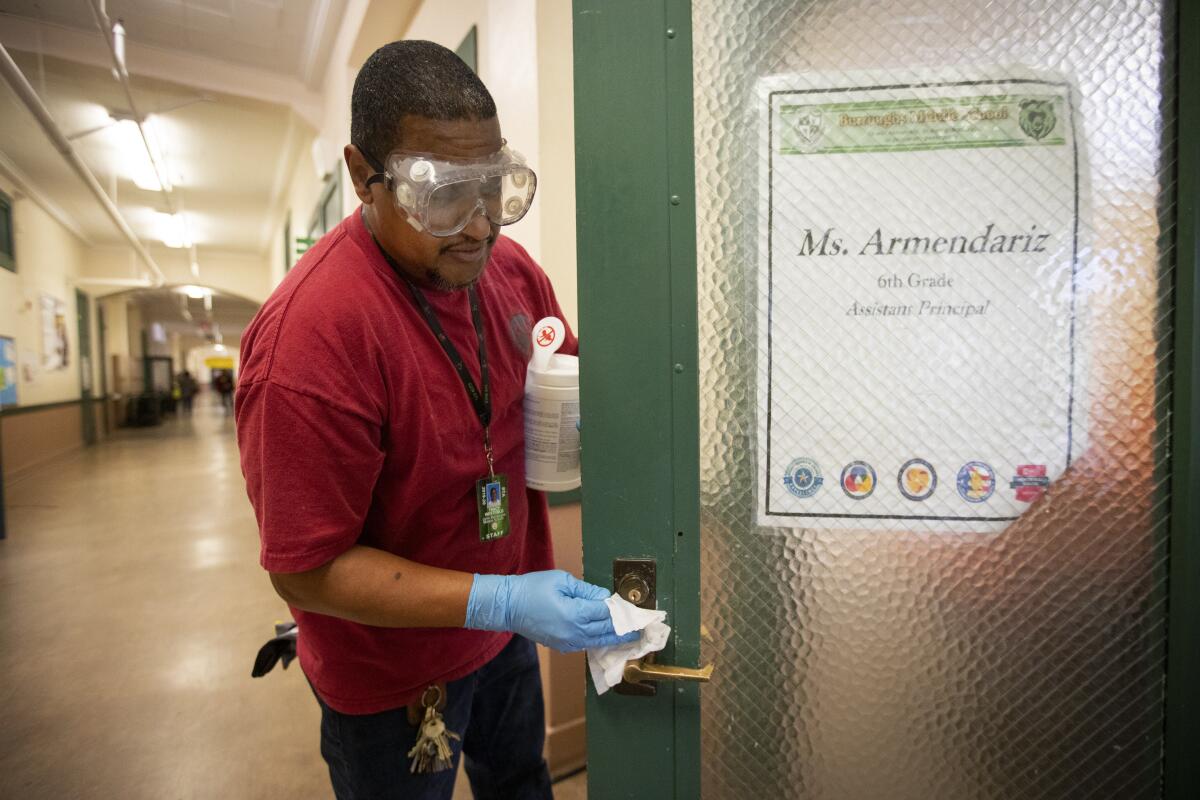
- Share via
School districts across Southern California are sending out message blasts to parents, urging calm and good hygiene practices. Many schools are bulk ordering hand sanitizers, deep cleaning classrooms and scrubbing “high touch” areas, such as drinking fountains and bathroom sinks. Several are considering using online lessons to keep students learning in the event of closures.
As the number of coronavirus cases reported in California have increased, school officials are racing to educate students and families about the epidemic and slow the spread of germs among so many children, while also preparing contingency plans if they are forced to shut their doors — as several schools have already done in Washington, Oregon and Northern California.
There have been nearly 50 coronavirus cases reported in the state, most of which involve people who contracted the virus abroad and were then repatriated to the U.S. and quarantined on military bases. In at least five cases, people contracted the virus in their community. Health experts have said that an increase in the number of cases in the nation does not necessarily mean that the virus is spreading rapidly.
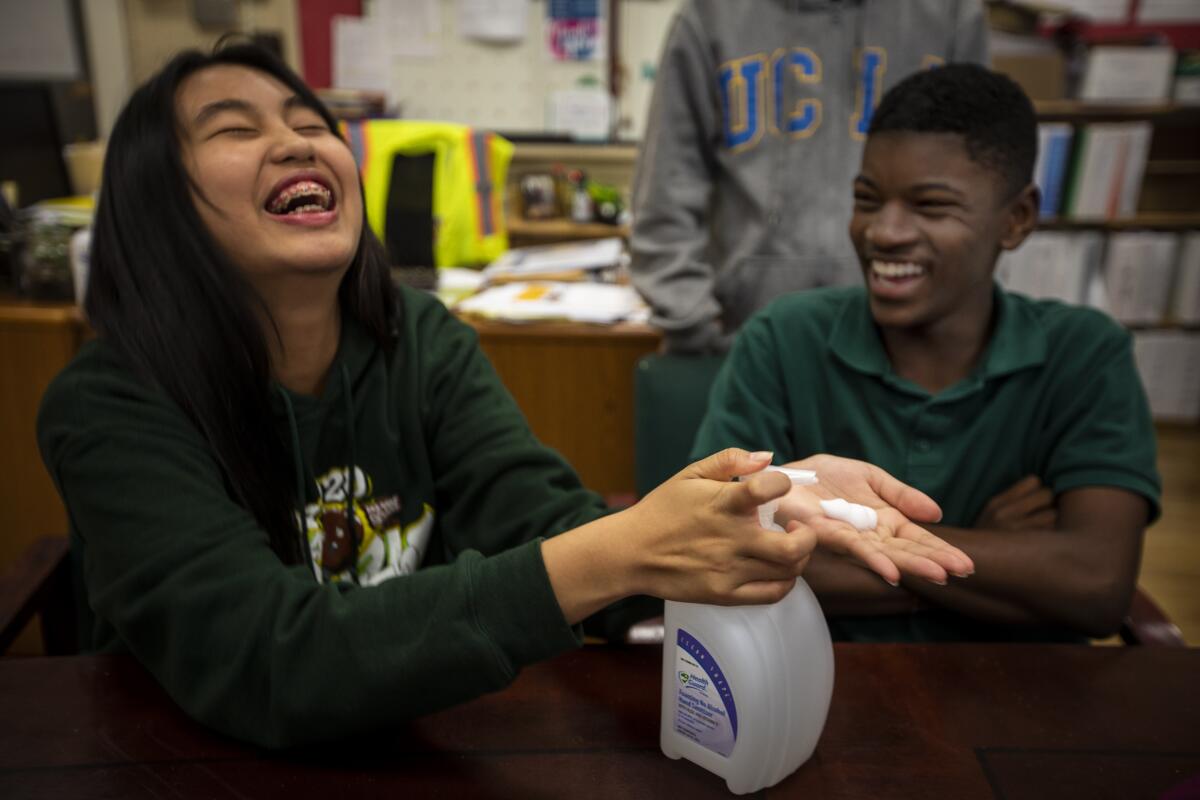
Nevertheless, school officials across the state are doing their best to prepare in an anxious environment.
At L.A. Unified School District, an official checks in every day with the county health department and asks three questions: Is anyone sick in L.A. County? Are there any exposures affecting schools? Can we go about things normally?
So far the answers have been: no, no, yes.
Schools are operating as usual, with algebra tests, lunch lines and basketball games in the gym. But officials know that could change.
“We’re prepared as best we can be, recognizing this as uncharted waters for all of us,” said L.A. schools Supt. Austin Beutner.
That preparation included a 90-minute meeting Monday at district headquarters with labor groups. The union representing teachers, counselors, librarians and nurses was represented by Alex Orozco.
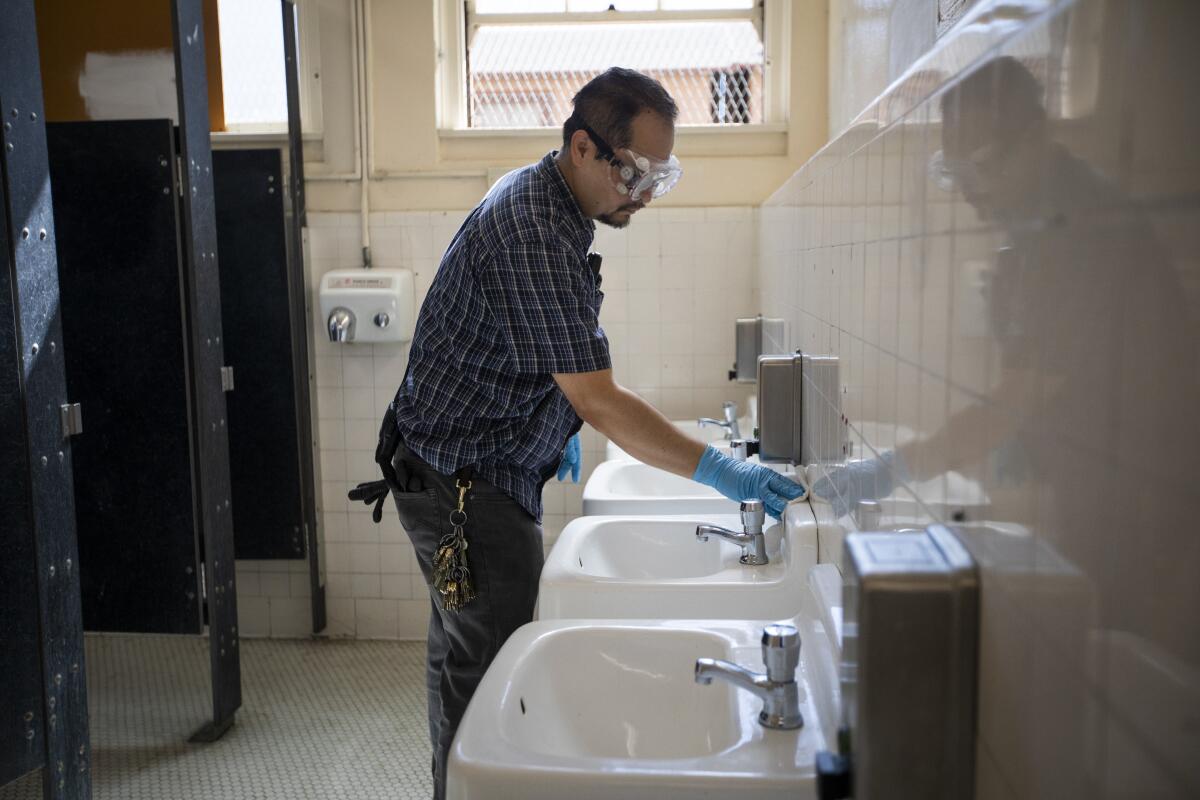
Orozco wanted reassurance that district employees would not be penalized “when it comes to having to miss work” related to the coronavirus. And as far as hygiene goes, “we want to make sure students have enough time to wash their hands” within the regimented schedule of the school day, said Orozco, who is the designated disaster-response liaison for United Teachers Los Angeles.
Beutner seemed sympathetic on both points, Orozco said.
Scrubbing classrooms, washing hands
Beutner said that Deputy Supt. Megan Reilly is in charge of the district’s response and that teams are at work in every facet of operations in the nation’s second-largest school system. At the school level, overtime pay is available to allow for deeper and more thorough cleaning of “high-touch” areas.
Towel dispensers, doorknobs, staircase railings, computer keyboards, toys in a kindergarten classroom, seats on buses, the coffee pot handle in the faculty lounge. The list goes on.
District planners have been asked to plan for a myriad of scenarios: What would happen if most of the payroll department called in sick? What if the IT department needed to be quarantined or if there was a break in the supply chain of the vast food-services operation?
Like some other school systems, including those in Long Beach and Glendale, L.A. Unified is able to reach parents and staff by phone or email through automated systems. These districts and others also have set up a web page for bulletins, general information and links.
A key task is providing accurate information and tamping down premature alarm, Glendale Supt. Vivian Ekchian said.
She has directed that every inquiry be answered individually, although often that answer is simply a referral to an L.A. County or Centers for Disease Control and Prevention online answer sheet.
L.A. Unified has an information video and a telephone hotline that is staffed from 6 a.m. to 5 p.m. The number is: (213) 443-1300.
Preparing for the possibility of closures
The most difficult scenario is one or multiple school closures.
School districts said they would rely on public health officials to decide if and when schools should shut their doors. That could happen if, for example, a student or staff member is diagnosed with coronavirus, said Debra Duardo, the L.A. County superintendent of schools.
But she said, “we’re not there yet.”
Still, the county office is reaching out to districts to make sure they have ways to keep students learning if a campus is closed, Duardo said.
School districts are discussing online learning. Some schools have laptops and other devices that students can take home, while some districts are exploring additional possibilities. In the Pasadena Unified School District officials are thinking about tapping into the district’s TV station to help supplement learning, spokeswoman Hilda Ramirez Horvath said.
But these strategies become especially tricky in districts that serve low-income families. Many lack internet access at home; for many, the only family computer is a shared smartphone.
Duardo said that even without technology, teachers can find ways to be effective.
“I don’t think it really matters the form you’re using for instruction, even if it’s the old-fashioned providing an instructional packet, with some good back-and-forth communication, a lot of learning can continue to take place,” she said.
At Paramount Unified School District in Southeast L.A., where officials recently ordered alcohol-based hand sanitizer for their classrooms, Supt. Ruth Pérez is thinking about the heavy burden of possible school closures on families with few childcare options.
The district of about 15,000 students is about 90% Latino and 94% low income.
“All students in grades three through 12 have Chromebooks,” Pérez said. Although not all families have their own internet access, at least several hundred have access to hotspots provided as a public service by Sprint. “We also have materials and textbooks on Chromebooks that you don’t need internet access for.”
Doing schoolwork at home “is always a possibility but there are parents who work and leaving a third- or fourth-grader at home by themselves is something we would want to avoid,” Pérez said.
When it comes to closures, L.A. Unified at least has one painfully earned planning advantage: It has dealt with shutdowns before. In the last several years, a hoax terrorist threat shut down the entire school system for a day; fires shut down campuses across the San Fernando Valley, and a teachers’ strike virtually brought instruction to a halt for six days.
During those crises, L.A. Unified’s responses earned a mix of praise and criticism. During recent wildfires, for example, some faulted the school system for waiting too long to cancel classes. Yet officials carried out the widespread school closures in potentially hazardous conditions without incident.
What colleges are doing
University officials are also preparing and responding to the virus.
Four students in the Los Rios Community College District — two at Sacramento City College and one each at American River College and Cosumnes River College — reported exposure to an individual confirmed to have COVID-19.
All of the exposures happened while the students were working off campus as medical professionals, the district said on its website. They were told to self-quarantine for 14 days and report any symptoms to county health officials.
The district has had no confirmed infections so far. County health officials directed all three colleges to proceed normally with class and work schedules.
“Out of an abundance of caution, all campuses have implemented enhanced cleaning practices in high-traffic areas,” the district said.
Paul Feist, vice chancellor for communications and marketing at the California Community Colleges Chancellor’s Office, said no colleges have closed as a result of the outbreak, and he was not aware of any community college students with confirmed cases of COVID-19.
Chancellor Eloy Ortiz Oakley directed colleges to review their emergency operations plans, Feist said, and a web page is available to keep colleges up to date.
Mike Uhlenkamp, spokesman for Cal State’s chancellor’s office, said that before last week, the university had focused on restricting travel to affected countries and ensuring students who were overseas were safe.
But on Friday, two days after the CDC announced it was investigating the first possible case of “community spread” of coronavirus in the U.S., the university activated its “emergency operations center,” a virtual forum where the chancellor’s office and university campuses can share updates about the virus and community responses.
No cases of COVID-19 have been reported among Cal State students or staff to date, Uhlenkamp said. It will be up to individual college presidents to decide whether to close their campuses.
Uhlenkamp said all Cal State campuses have pandemic and continuity of operations plans.
“We’ve encouraged them to review those,” he said. “Get your decision makers on the same page so you can move swiftly.”
At the University of California, the Office of the President put out guidelines for all locations. The 19-page document includes information about distributing masks, taking family and medical leave, quarantining students, and reporting cases to local or state health authorities, among other questions.
Three UC Davis students had been placed in isolation but were released after one tested negative for the virus.
As they make their preparations, many school officials say that for now the biggest concern is calming worried families.
“We need to be prepared so there’s the least amount of disruption in learning,” said Duardo, the L.A. County schools superintendent. But, she added, “there’s a lot of fear and I think, unfortunately, some of it is unnecessary anxiety among children.”
More to Read
Sign up for Essential California
The most important California stories and recommendations in your inbox every morning.
You may occasionally receive promotional content from the Los Angeles Times.

